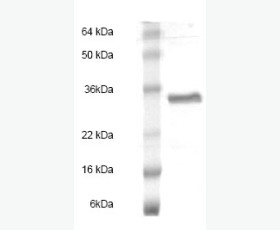Recombinant Human Ephrin B Receptor 1/EphB1
| Product name: | Recombinant Human Ephrin B Receptor 1/EphB1 |
| Source: | Human Cells |
| Purity: | Greater than 95% as determined by reducing SDS-PAGE. |
| Buffer Formulation: | Lyophilized from a 0.2 μm filtered solution of 20mM Tris,150mM NaCl,pH8.0. |
| Applications: | Applications:SDS-PAGE; WB; ELISA; IP. |
| Storage: | Avoid repeated freeze/thaw cycles. Store at 2-8 oC for one month. Aliquot and store at -80 oC for 12 months. |
| UOM: | 100ug/50ug/200ug/1mg/1g |
SourceHuman CellsDescriptionRecombinant Human Ephrin B Receptor 1 is produced by our Mammalian expression system and the target gene encoding Ser564-Ala984 is expressed with a 6His tag at the C-terminus.NamesEphrin Type-B Receptor 1, ELK, EPH Tyrosine Kinase 2, EPH-Like Kinase 6, EK6, hEK6, Neuronally-Expressed EPH, Related Tyrosine Kinase, NET, Tyrosine-Protein Kinase Receptor EPH-2, EPHB1, ELK, EPHT2, HEK6Accession #P54762FormulationLyophilized from a 0.2 μm filtered solution of 20mM Tris,150mM NaCl,pH8.0.ShippingThe product is shipped at ambient temperature.
ReconstitutionAlways centrifuge tubes before opening. Do not mix by vortex or pipetting.
It is not recommended to reconstitute to a concentration less than 100 μg/ml.
Dissolve the lyophilized protein in ddH2O.
Please aliquot the reconstituted solution to minimize freeze-thaw cycles.StorageLyophilized protein should be stored at < -20°C, though stable at room temperature for 3 weeks.
Reconstituted protein solution can be stored at 4-7°C for 2-7 days.
Aliquots of reconstituted samples are stable at < -20°C for 3 months.PurityGreater than 95% as determined by reducing SDS-PAGE.
EndotoxinLess than 0.1 ng/µg (1 IEU/µg) as determined by LAL test.Amino Acid Sequence
ReconstitutionAlways centrifuge tubes before opening. Do not mix by vortex or pipetting.
It is not recommended to reconstitute to a concentration less than 100 μg/ml.
Dissolve the lyophilized protein in ddH2O.
Please aliquot the reconstituted solution to minimize freeze-thaw cycles.StorageLyophilized protein should be stored at < -20°C, though stable at room temperature for 3 weeks.
Reconstituted protein solution can be stored at 4-7°C for 2-7 days.
Aliquots of reconstituted samples are stable at < -20°C for 3 months.PurityGreater than 95% as determined by reducing SDS-PAGE.
EndotoxinLess than 0.1 ng/µg (1 IEU/µg) as determined by LAL test.Amino Acid Sequence
MSRKRAYSKEAVYSDKLQHYSTGRGSPGMKIYIDPFTYEDPNEAVREFAKEIDVSFVKIEEVIGA GEFGEVYKGRLKLPGKREIYVAIKTLKAGYSEKQRRDFLSEASIMGQFDHPNIIRLEGVVTKSRP VMIITEFMENGALDSFLRQNDGQFTVIQLVGMLRGIAAGMKYLAEMNYVHRDLAARNILLNSNLV CKVSDFGLSRYLQDDTSDPTYTSSLGGKIPVRWTAPEAIAYRKFTSASDVWSYGIVMWEVMSFGE RPYWDMSNQDVINAIEQDYRLPPPMDCPAALHQLMLDCWQKDRNSRPRFAEIVNTLDKMIRNPAS LKTVATITAVPSQPLLDRSIPDFTAFTTVDDWLSAIKMVQYRDSFLTAGFTSLQLVTQMTSEDLL RIGITLAGHQKKILNSIHSMRVQISQSPTAMAVDHHHHHH
BackgroundEphrin Type-B Receptor 1 (EPHB1) is a single-pass type I membrane protein that belongs to the Ephrin-B family of receptor tyrosine kinases that is involved in embryonic nervous and vascular system development. EPHB1/EPHT2 contains two fibronectin type-III domains, one protein kinase domain and one SAM (sterile α motif) domain. EPHB1 could stimulate fibroblast motility on extracellular matrix in a kinase-dependent manner, which also correlated with its association with Grb7, an adaptor molecule implicated in the regulation of cell migration. It binds to ephrin-B1, ephrin-B2 and ephrin-B3. EPHB1 plays an important roles in diverse biological processes including nervous system development, angiogenesis, and neural synapsis formation and maturation and may be involved in cell-cell interactions in the nervous system.













